Practical Airsoft Recommends:

Tears Of The Sun (DVD)

Tears Of The Sun (VHS/PAL UK Video)

Tears Of The Sun (Soundtrack CD)

Fuji Finepix A204 digital camera

Cobra Microtalk 110 PMR446 2-way radio
The Elite 85...
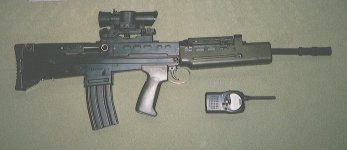
A little comparison, to start with. The table below shows a comparison of the data between the only mass-produced bull-pup format Airsoft assault rifle models, the Tokyo Marui FA-MAS & Steyr AUG Military, and Elite 85 custom AEG assault rifle model, and, for comparison with the so-called 'real steel', the L85A1 military firearm.
Name: |
FA - MAS |
AUG Military |
Elite 85 |
L85A1 |
Type: |
Assault Rifle | Assault Rifle | Assault Rifle | Assault Rifle |
Manufacturer: |
Tokyo Marui | Tokyo Marui | Elite (Custom) | Royal Ordnance / Heckler und Koch GmBH ("H&K") |
Power: |
Electric | Electric | Electric | Gas operated Firearm |
Action: |
Semi - Auto & Auto | Semi - Auto & Auto | Semi - Auto & Auto | Semi - Auto & Auto Firearm |
Motor: |
EG560 | EG700 | EG560 | N/A |
Battery: |
Large 8.4 1600mAh |
Mini 8.4 600 mAh |
Mini 8.4 600 mAh |
N/A |
Length: |
757mm | 805mm | 780mm | 785mm |
| 3.0 kg | 3.5 kg | 2.5 kg | 4.98 kg | |
Barrel Length: |
488mm | 510mm | NOT KNOWN | 518mm |
Range: |
45 feet | 45 feet | 45 feet | 300 metres effective |
Muzzle Velocity: |
285 fps | 285 fps | 285 fps | Approx 940 Metres/Sec |
RPM: |
1000 | 750-850 | 1000 | 800 |
Capacity: |
60 rounds 6mm Airsoft bb |
80 rounds 6mm Airsoft bb |
60 rounds 6mm Airsoft bb |
30 rounds 5.56 x 45 mm NATO |
Hi-Capacity: |
300 rounds 6mm Airsoft bb |
330 rounds 6mm Airsoft bb |
300 rounds 6mm Airsoft bb |
NOT AVAILABLE |
Sights: |
Iron | Optical, 2x15 |
Optical (nil power) or red-dot |
Optical SUSAT 4 power-unity |
Overview
The first Airsoft L85A1 was a self-assembly spring-powered kit, manufactured by L&S in the very early 1990's, which fired hollow ASGK 'miniature shuttlecock-like darts'; this was very soon modified to incorporate the now standard 6mm 0.2 gram polymer bb pellet that we are now so familar with.
Following this, there has been one mass-produced, and one custom L85A1 since then; Airsoft Korea produced a small-run custom L85A1 until very recently. A visit to their web site in mid December 2000 showed that they no longer (well, right at the moment, anyhow) manufacture it, and MFI, who currently manufacture their own version of the L&S spring model, along with an electric version (link to their product page here) with the spring mechanism replaced by the motor and gearbox from a Marui FA-MAS.
Enter the Elite
The Elite 85 utilises the same principle as the MFI offering, by cannibalising a Marui FA-MAS, M16, and the bodywork from the L&S kit, with a few extra components to make it all work together.
Notes on the 'real steel' rifle
The real world L85A1 (otherwise called the 'SA-80') has come in for some real stick in its service life, with all manner of problems, ranging from a several million Pounds re-fit to cure feed jams, blockages through dirt, sticking extractors, broken firing pins, fracturing plastic furniture, and so on, resulting in yet more concerns of late, due to a continued failure to pass the UK MoD's sand and mud tests, as well as the average soldier's perception that it takes forever to keep it clean and serviceable (just to number a few problems!)
Never the less, refitting the entire United Kingdom's Armed Forces with a new rifle system is not a thing to be approached lightly, not only due to the immediate cost of purchasing the rifles, but for the added cost of re-training the troops in it's useage as well. So, the L85A1 is here to stay, probably until the end of it's intended service life, sometime in 2021.
Onto the Elite 85 Airsoft model
Similarly, the single Airsoft mass-produced version (no longer in production, as I understand it, marketted by L&S, as a self-assembly kit, has been consistently similar in it's failings, in that it's hideously under-powered for a spring-powered Airsoft rifle. However, in its favour, the L&S kit HAS introduced a generation of Airsoft gamers to the hobby.
With this in mind, and following a few requests from his customers, Tom Andrews, the boss of Elite Action Games, manufactured a couple of prototype AEG models. Following the same route as MFI in the United States, but apparently before MFI had undertaken their project, he decided to utilise the afore-mentioned off-the-shelf components as much as he could; the result was an order, announced in mid December 2000, for twelve of the models, for a milsim site in Wales.
I visited Tom at his home, located in the western suburbs of outer London (actually, more like Eastern Surrey) on the 5th of December 2000, where he showed me how the model was assembled. Reminding me of the recent order he'd received for this model, he apologetically informed me that the only model of it he could now show me was the prototype, which was, as it is the prototype, he explained, a little rough around the edges!
 Based around the gearbox and EG560 motor from a Marui FA-MAS AEG model (photo, right - ignore the lump on the right of the photo, it's rifle's the butt-plate), the Elite 85 is a hybrid model, with yet more parts from the L&S L85A1 springer, Marui FA-MAS, and a replacement M16A1 barrel and hop-up mechanism, and a small number of custom electrical parts, to allow the rifle to work. If it wasn't so well constructed by Tom, you could almost call it a cannibalised rifle!
Based around the gearbox and EG560 motor from a Marui FA-MAS AEG model (photo, right - ignore the lump on the right of the photo, it's rifle's the butt-plate), the Elite 85 is a hybrid model, with yet more parts from the L&S L85A1 springer, Marui FA-MAS, and a replacement M16A1 barrel and hop-up mechanism, and a small number of custom electrical parts, to allow the rifle to work. If it wasn't so well constructed by Tom, you could almost call it a cannibalised rifle!
The first thing you notice about the Elite 85 it it's weight - it's light, but well-balanced; the real world L85A1 (which I had the mis-fortune to use while serving seven odd years in the Territorial Army) is roughly 12 or so pounds, unloaded. The Elite 85 is roughly six pounds, loaded, a much lighter, and overall easier weight to manage for Airsoft skirmishing. Visually, it's a very close approximation to the real rifle, even down to the colour of the butt-plate, cheek-piece, pistol grip, and front furniture (olive green), and the stamping on the right foregrip, which states "5.56mm L85A1", followed by a Nato Stock Number (NSN), which if memory serves, looks authentic!
However, there are a couple of noticeable flaws in this model, which, frankly, I'm not especially surprised at, given the source of the components. The cocking handle/bolt assembly is fixed, and does not move; the ejection port dust cover opens, but instead of the body of the rear of the bolt, and internal working parts of the TMH (Trigger Mechanism housing, the lower half of the real rifle) to the rear of the bolt, reveals the top right side of the barrel and gearbox (weather-proofed by Tom). The hop-up mechanism is, instead, changed by the judicious use of a small screw on the left side of the rifle body, which turns a small cam over the chamber of the barrel, instead of the more expected knurled dial on most modern Marui models.
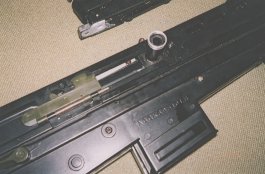 Also, the cocking handle is just plain wrong: While quite similar to the one fitted to the straight-pull single-shot version of the L85A1, the Cadet Rifle (the GP L98A1), the overall result is that this part is incorrect in both size and shape (it's too long, and too narrow, and a plastic-like Dural material, not the adonised metal of the original L85A1 rifle). Tom is working on this, and future versions of this custom-built model should sport an altogether more realistic cocking handle.
Also, the cocking handle is just plain wrong: While quite similar to the one fitted to the straight-pull single-shot version of the L85A1, the Cadet Rifle (the GP L98A1), the overall result is that this part is incorrect in both size and shape (it's too long, and too narrow, and a plastic-like Dural material, not the adonised metal of the original L85A1 rifle). Tom is working on this, and future versions of this custom-built model should sport an altogether more realistic cocking handle.
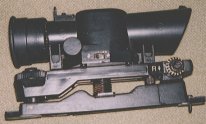 The next thing you notice, is the sight unit: This is black ABS plastic (not metal), and modelled on the SUSAT ("Sight Unit, Small Arms, Trilux" in Army language) fitted to the real 'teeth arms' version of the L85A1 (the 'all arms' version comes with a front-post and rear-sight carrying handle Iron Sights combination), but quite different internally. For one thing, there's no sealed red TRILUX (a low-level radioactive Tritium light source) element, and no magnification optics to it.
The next thing you notice, is the sight unit: This is black ABS plastic (not metal), and modelled on the SUSAT ("Sight Unit, Small Arms, Trilux" in Army language) fitted to the real 'teeth arms' version of the L85A1 (the 'all arms' version comes with a front-post and rear-sight carrying handle Iron Sights combination), but quite different internally. For one thing, there's no sealed red TRILUX (a low-level radioactive Tritium light source) element, and no magnification optics to it.
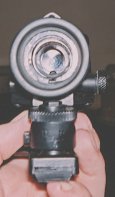 While the real world SUSAT features a 4-power single-hollow post sight picture (which can be illuminated from the red TRILUX source, the sight picture through this version is no-existent. Instead, Tom's replaced the rubbish that came with the L&S model, with a red-dot battery-powered unit. Thus, you sight with both eyes open, and watch for the red dot to 'appear' on the target you're aiming at, an altogether tried and trusted method.
While the real world SUSAT features a 4-power single-hollow post sight picture (which can be illuminated from the red TRILUX source, the sight picture through this version is no-existent. Instead, Tom's replaced the rubbish that came with the L&S model, with a red-dot battery-powered unit. Thus, you sight with both eyes open, and watch for the red dot to 'appear' on the target you're aiming at, an altogether tried and trusted method.

 Power-source-wise, the Elite 85 is powered by a standard 8.4v small ni-cad rechargable battery, that fits neatly into the front furniture of the model.
Power-source-wise, the Elite 85 is powered by a standard 8.4v small ni-cad rechargable battery, that fits neatly into the front furniture of the model.
This is a major problem, tactically, as one has to remove the front furniture, in its entirety (not the barrel shroud, though, which was removed in the photos here as part of a complete strip-down), in order to change the battery. The MFI model (noted above) gets around this in their 'version 2' L85A1s, by installing a 'trap door' in the underside of the furniture.
Until, therefore, such time as Tom has come up with a fast way of replacing the battery, this will remain a problem, as you need to remove the forward sling swivel (large screw mounting), open the top cover (see the photos above), and fiddle around until the green plastic of the furniture can come off. Reassembly, incidentally, is a difficult move, even if you aren't in a hurry.
Never the less, the battery and motor combination provides a rate of fire that is quite good (similar to the Marui FA-MAS); a standard 60 round magazine empties in around 3 and a half seconds; again on magazines, it accepts a standard Marui M16 magazine (including the extended capacity clockwork magazines as well). The only problem that I could pick up here, was the possibility, as in the original service version (pre-modifications), whereby a magazine could be accidentally ejected, by pressing on the magazine release catch, on the rear left of the body of the rifle. A small fault, but at least faithful to the original rifle!
Opening up the Elite 85
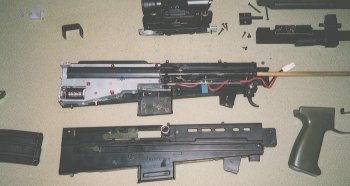 Opening up the Elite 85 is not simple. Instead of the simple two-pin cam-shell system of the real L85A1, the Elite 85 requires that you remove several screws, and open it up vertically, along the centre-line of the model. These screws are small, and inevitably fiddley: I'd suggest you have either a rather large mat, or very clean work bench, if you intend anything but the most cursory of maintenance to this model.
Opening up the Elite 85 is not simple. Instead of the simple two-pin cam-shell system of the real L85A1, the Elite 85 requires that you remove several screws, and open it up vertically, along the centre-line of the model. These screws are small, and inevitably fiddley: I'd suggest you have either a rather large mat, or very clean work bench, if you intend anything but the most cursory of maintenance to this model.
Never the less, what is revealed is surprisingly simple, well laid out, and, if you know what you're doing, straight-forward to work on. Fully sixty percent of the interior is used up by the gearbox/motor assembly, which is connected in turn to a rod, leading to the trigger, in the same manner as a Marui FA-MAS.
 The air nozzle at the front of the gearbox/motor assembly interfaces neatly with the hop-up/feed assembly from an M16A1 (pictured on the right, with the gearbox / motor assembly removed, for clarity. Tom used a LOT of silicon grease on the air nozzle/feed assembly joint!), which in turn leads to the barrel itself. The barrel is a full-length affair, and is shrouded after leaving the rear body work by the normal simulated barrel that you find on all AEGs these days. Tom tells me that it's normal to find that the L&S body kits come with one of two types of shroud; a metal one, and a plastic one; the prototype is fitted with the metal variant, giving it a little more strength and robustness.
The air nozzle at the front of the gearbox/motor assembly interfaces neatly with the hop-up/feed assembly from an M16A1 (pictured on the right, with the gearbox / motor assembly removed, for clarity. Tom used a LOT of silicon grease on the air nozzle/feed assembly joint!), which in turn leads to the barrel itself. The barrel is a full-length affair, and is shrouded after leaving the rear body work by the normal simulated barrel that you find on all AEGs these days. Tom tells me that it's normal to find that the L&S body kits come with one of two types of shroud; a metal one, and a plastic one; the prototype is fitted with the metal variant, giving it a little more strength and robustness.
The really surprising thing about this rifle is the fuse - there isn't one!
 Instead, Tom has installed a thermal cutout device (the blue rectangular bit in the photograph to the left, with the screwdriver pointing to it), which resets after a few moments, in the event of an over-voltage fault. This means that you don't need to worry overly about having to open up your rifle in the middle of the battle-field, should the fuse blow - it'll automatically re-set itself, allowing you to carry on, but a little more cautiously, until you can safely find a place to open it up, and fix the problem causing the thermal cutout to trip open. Neat idea, and one that, in my opinion, Marui should have used! Full marks, Tom!
Instead, Tom has installed a thermal cutout device (the blue rectangular bit in the photograph to the left, with the screwdriver pointing to it), which resets after a few moments, in the event of an over-voltage fault. This means that you don't need to worry overly about having to open up your rifle in the middle of the battle-field, should the fuse blow - it'll automatically re-set itself, allowing you to carry on, but a little more cautiously, until you can safely find a place to open it up, and fix the problem causing the thermal cutout to trip open. Neat idea, and one that, in my opinion, Marui should have used! Full marks, Tom!
On the user-servicability side, while I say it's well laid out, and simple to work on, it's not - say again not - for the faint hearted or inexperienced player. You do have to open it up, to clear jams and other problems, a process that requires patience, good hand-eye co-ordination, and a very clear working area, as parts can drop out of the model, requiring a search for the more fiddly and small screws (etc) that could 'go walkies'. Never the less, unlike some models that I've worked on (The Marui AUG military is one such example!), it's simple enough when you get there.
Playability and operation
On the playability side, now. Remembering that this rifle is a 'bull-pup' configuration, where the magazine housing is behind the pistol grip, there are those players who just don't like the format; I'm not one of them, personally. I say this for one reason: It's a multi-purpose model, good for both field and woodland conditions, as well as urban games. The model possesses a full-length barrel, even if you can't see all of it (half of it's INSIDE the body of the rifle), overall length is short, compared to most 'conventional' rifles out there, thus making it good for the halls, rooms, and corridors of urban games, where most players will be using SMG format models, and, in short, makes your logistics that much easier, as you only require one model (possibly a pistol as well, if you're so inclined) for an entire day's gaming, wherever you find yourself.
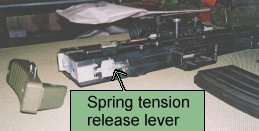 The Elite 58 also sports a working 'change lever', as in the real rifle; there is no 'off' switch, as in the FA-MAs, though Tom HAS included the tension release button on the underside of the rear stock, which in my opinion is a valuable safety feature: It allows you to release the piston spring pressure, thus allowing clearing of the model to be effected completely and safely, prior to stripping the rifle down, when neccessary.
The Elite 58 also sports a working 'change lever', as in the real rifle; there is no 'off' switch, as in the FA-MAs, though Tom HAS included the tension release button on the underside of the rear stock, which in my opinion is a valuable safety feature: It allows you to release the piston spring pressure, thus allowing clearing of the model to be effected completely and safely, prior to stripping the rifle down, when neccessary.
Detail-wise, this model possesses, as you would expect these days, very good plastic detail, but unfortunately, lacks many of the metal parts found on more modern airsoft models. Parts like like the barrel, flash suppressor, cockling handle, and sling swivels are usually metal if manufactured after 1998, from, say, Tokyo Marui. In this case, as the majority of the external body of the Elite 85 is from an L&S kit, the metal features are not there; instead, you get ABS plastic, which, while reasonably solid, won't last long if placed under a lot of heavy strain.
In use...
I visited Elite Action Games (Tom's gaming site, near Worthing in West Sussex) on 7th January 2000, where I tested the Elite 85 'in action'.
The model I used was NOT the model I'd seen at Tom's home, as shown above. That model had been leant to another player a couple of weeks before, and had not made it back into his hands. Instead, I got prototype number 2, which, while OK, was not as robust as prototype number 1, as the barrel shroud was ABS plastic. Also, the sight unit was NOT a red dot sight, but the original L&S cross-hair rubbish.
First off, the main points:
- Good point:
- The standard sling for an L85A1 (available from most good surplus shops) fits the model just fine, and works just as it should, supporting the model correctly.
- Bad point:
- For some reason, the barrel retetion screw was loose, and the model subsequently suffered horrendous barrel wobble. This can be cured by checking the retention screw BEFORE setting off to a game.
- Good point:
- The rifle is really light, compared to some on the market, making it a joy to cart about the playing area.
- Bad point:
- If you don't get the red-dot sight, the chances are that you're gonna miss everything in sight.
- Good point:
- The rate of fire was equal to that of an FA-MAS, making suppresion fire a joy.
- Bad point:
- If you don't set the hopup properly, you loose range dramatically. I found this out AFTER I'd engaged the enemy, when I didn't have a cross-head screwdriver to sort things out.
- Good point:
- It accepts a standard small 600mAh battery, like the AUG, Colt XM177, Colt M16M4, and a few more besides.
- Bad point:
- When your battery runs out, that's it. You're stuffed. You need to leave the playing area, return to base, and replace it, as you need, once again, a screwdriver to do the job.
- Good point:
- It accepts standard and high-capacity Marui M16 magazines with no problem whatsoever.
- Bad point:
- The lack of a shroud around the magazine release catch caused me no end of problems, as in the real world early L85A1 rifles, as, when the model bounced against me, the catch would disengage, and - plop - the magazine would dump, most times into the bloody mud. Not good.
In summary, then...
You might think that I dislike the model, after what I've said above. Not so, actually. Remembering that these two models were prototypes, it's to be expected that there'll be a few problems with them.
Production models, when Tom's fixed the problems above, should be a great joy to own and use; priority, however, I have to say, in the snagging list, would be, in my eyes, anyhow:
- Design and fit a magazine catch shroud, as in the real L85A1. This should be easy enough, as Plastic card is dead easy to work with.
- Figure out a practicable method of performing tactical battery changes. The existing mechanism/assembly just doesn't fly in the face of the opposition teams out there.
- Strengthen the barrel shround retention screw, or add another way of securing it.
- Make the hop-up adjustment simpler, thereby removing the need for a screwdriver.
Overall, then, I like this model. Once Tom has the problems sorted out to my liking, I'll be saving the cash to buy one from him, should my own AUG prove unfixable (that's another damn story COMPLETELY!). I can;t be fairer that that, now, can I?!
Costs...
As the model is a combination of parts from different existing models, pricing for each Elite 85 will probably vary a little; as a base guide, however, price depends on which parts you supply; because the gearbox Tom uses is a version one gearbox, and only used in the Marui FA-MAS, there is no aftermarket for third-party gearboxes, so these either have to come from Marui as a spare part (difficult as best), or from an existing Marui FA-MAS model. Other parts are not so much of a problem, luckily. So, the minimum price I could nail Tom to, which includes him supplying every component, including the red dot replacement sight, is £400. This includes battery, charger, and hicap mag. Delivery times vary, so if you order one from him, get an estimate of the turn around time as well.
Unfortunately, I was not able to play a game with this model, (a) due to time constraints, and (b) as it was a weekday night! I will, however, try to get a hands-on play test addition to this article by the end of January 2001, to fully round out the review.
My thanks to Tom Andrews of Elite Action Games, for his enthusiastic assistance with this article.
On a slightly more personal note, next time I go skirmishing after having just recovered from the 'Flu, someone bloody shoot me! God, I was a mess, yesterday (7th January 2001) - coughing up... well, you don't need (or really want, either, I suspect!) to know. Suffice to say, I wasn't really fit enough for a good, energetic, day's skirmish gaming! Oh, my aching body!







